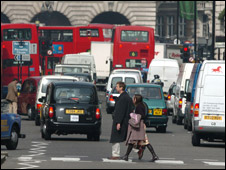A Vision for London 构想伦敦
收听与下载
The script of this programme 本节目台词
John: Today we're talking about a new Vision for London, the title of an exhibition at the New London Architecture Galleries in London*. I'm John.
Jean: 伦敦新构想。I'm Jean and I'll be helping out with some Chinese explanations in today's programme.
如果你从未来到过伦敦,你对伦敦会是一个怎样的想象?如果让你来设计伦敦,你会如何改变这座世界闻名的城市呢?也许你会想在市中心多开辟一些可以让人们避开喧嚣车辆的广场,或者更多的公园和没有车辆来往的区域?
Would you like to see more public squares, more parks and car-free areas?
John: Well, at a gallery devoted to London's future we discovered the Vision for London exhibition. Its aim? Simply to bring together all the ideas of architects and designers to create a better London.

London's streets can be unpleasant for pedestrians
Jean: Sounds good. 这次展览的目的是为了向大众展示一些建筑师和设计师的新设想 architects and designers, and to hear about their vision of London's future 他们为伦敦所做的未来构想。
John: The BBC's Mike Ramsden explored the work of one man who also has a vision for London.
Jean: It's the architect Sir Terry Farrell. BBC 的记者 Mike Ramsden 采访了著名建筑师 Terry Farrell 爵士,探讨了他对伦敦未来的伟大构想。我们接下来会听到记者Mike 为我们解释 Terry Farrell 爵士的这个构想。
John: Sir Terry wants to make sure pedestrians- or people who walk on foot - in London are given priority.
Jean: 行人 pedestrians, 是建筑师在构想上的第一要素。让我们来听一小段 Mike 的采访录音。
The big idea - put the pedestrian first. Design round their needs, not the needs of traffic.
Mike Ramsden, BBC reporter
Jean: Controversial.
John: Putting pedestrians before cars.
Jean: 行人比车辆更优先。
John: Design around their needs, not the needs of traffic.
Jean: 伦敦的这些地区的设计是为了方便行人的需要 the needs of pedestrians, 而不是为了方便车辆交通的。
John: Okay now Jean, what was the first thing that you noticed about London when you came?
Jean: Well I arrived by train, and around the train station it was chaotic. 我第一次坐火车来到伦敦的时候觉得这儿的火车站真是真够乱的。There were cars stopping and starting, there were buses everywhere, and you just couldn't move!
John: So do you think anything could be done about that?
Jean: No, it's just not possible surely.
John: Well, listen again to Mike Ramsden. He's found a similarly busy area in London, which sounds quite like your first London experience.
Jean: Okay, 我们的记者 Mike 来到了伦敦两大热闹街道的交界处,he's at the junction of two busy streets. 在这里到处都是行驶的车辆,也有不少的人行横道 pedestrian crossings, 不过这里并不是人们喜欢多逗留的地方,因为街上是又挤又吵、空气又污染。而 Mike 说他找到了一个可以解决这个问题的人。
Can anything be done to improve somewhere like the junction between Euston Road and Tottenham Court Road? There are 16 pedestrian crossings, nearly 40 traffic lights, surely it’s beyond saving. But Sir Terry Farrell, famous London architect, says he can make this junction work for traffic, and for pedestrians.
Mike Ramsden, BBC reporter
Jean: So how does he propose to make these busy London streets nicer for pedestrians?
John: Yes, very good question.
Jean: Well, Sir Terry Farrell has some ideas. 让我们来听听 Terry Farrell 的好主意吧。
It’s possible to totally re-design what we’re standing in the middle of, so that both win. And it would be a new place, a place with cafés and trees, much less tarmac. It’s never been designed holistically with joined-up thinking ever.
Sir Terry Farrell, architect
John: He said that the problem needs to be thought of holistically.
Jean: Terry 认为运用一个整体的方式就能解决这个问题。
John: There needs to be more joined-up thinking.
Jean: More joined-up thinking. 更多的整体思考。就是说,政府之中管理不同领域的各个部门需要相互合作、共同研究解决办法。为了解决伦敦的交通问题,使之变成一座更适合人们居住的城市,Terry 认为政府需要做更多的 joined-up thinking.
John: I wonder if Terry will succeed.
Jean: 那我们下次节目再见啦。
John: Bye.
*This programme was first produced in 2008